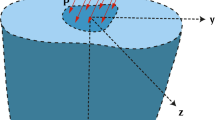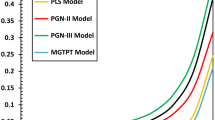Abstract
Semiconductor-based electronic devices usually work under multiphysics fields rendering complex electromagnetic–thermo–mechanical coupling. In this work, we develop a penalty function method based on a finite element analysis to tackle this coupling behavior in a metal/semiconductor bilayer plate—the representative unit of semiconductor antenna, which receives strong and pulsed electromagnetic signals. Under these pulses, eddy current is generated, of which the magnitude varies remarkably from one plate to another due to the difference in electrical conductivity. In the concerned system, the metal layer generates much larger current, resulting in the large temperature rise and the nonnegligible Lorentz force, which could lead to delamination and failure of the semiconductor-based electronic device. This study provides theoretical guidance for the design and protection of semiconductor-based electronic devices in complex environments.



Similar content being viewed by others
References
Klyuchnik AV, Pirogov YA, Solodov AV. Investigation of the IC resistance to pulsed electromagnetic radiation. J Commun Technol Electron. 2011;56(3):342–6.
Giles JC, Prather WD. Worldwide high-altitude nuclear electromagnetic pulse simulators. IEEE Trans Electromagn Compatibil. 2013;55(3):475–83.
Chakarothai J, Watanabe S, Wake K. Numerical dosimetry of electro- magnetic pulse exposures using FDTD method. IEEE Trans Antennas Propag. 2018;66(9):5397–408.
Li GJ, Amer N, Hafez HA, Huang SH, Turchinovich D, Mochain VN, Hegmann FA, Titova LV. Dynamical control over terahertz electromagnetic interference shielding with 2D Ti3C2Ty mxene by ultrafast optical pulses. Nano Lett. 2020;20(1):636–43.
Yeong-Kook O, Kim WC, Park KR, et al. Commissioning and initial operation of KSTAR superconducting tokamak. Fusion Eng Design. 2009;84:344–50.
Shimomura Y. Overview of International Thermonuclear Experimental Reactor (ITER) engineering design activities. Phys Plasmas. 1994;1:1612–8.
Radasky WA, Baum CE, Wik MW. Introduction to the special issue on high-power electromagnetics and intentional electromagnetic interference. IEEE Trans Electromagn Compatibil. 2004;46(3):314–21.
Shurenkov VV, Pershenkov VS. Electromagnetic pulse effects and damage mechanism on the semiconductor electronics. FACTA Univ Ser Electron Energet. 2016;29(4):621–9.
Baek JE, Cho YM, Ko KC. Analysis of design parameters reducing the damage rate of low-noise amplifiers affected by high-power electromagnetic pulses. IEEE Trans Plasma Sci. 2018;46(3):524–9.
Lee K, Ko K. Propagation model of high-power electromagnetic pulse by using a serial-parallel resistors circuit. IEEE Trans Plasma Sci. 2014;42(9):3309–12.
Deng FX, Cao QL, Han XT, Chen Q, Li L. Principle and realization of an electromagnetic pulse welding system with a dual-stage coil. Int J Appl Electromagn Mech. 2018;57(4):389–98.
Jin JM, Yan S. Multiphysics modeling in electromagnetics. IEEE Antennas Propag Magaz. 2019;61(2):14–26.
Tavakoli MH, Karbaschi H, Samavat F. Computational study of electromagnetic fields, eddy currents and induction heating in thin and thick work pieces. Commun Comput Phys. 2010;8(1):211–25.
Karimi M, Shahidi AR. Bending and buckling analyses of BiTiO3-CoFe2O4 nanoplates based on nonlocal strain gradient and modified couple stress hypotheses: rate of surface layers variations. Appl Phys A. 2019;125:530.
Stampfli R, Youssef G. Multiphysics computational analysis of multiferroic composite ring structures. Int J Mech Sci. 2020;177:105573.
Horie T, Niho T. Electromagnetic and structural coupled analysis with the effect of large deflection. IEEE Trans Magn. 1997;33(2):1658–61.
Tanaka Y, Horie T, Niho T. Simplified analysis method for vibration of fusion reactor components with magnetic damping. Fusion Eng Design. 2000;51:263–71.
Hu YD, Li J. Magneto-elastic combination resonances analysis of current- conducting thin plate. Appl Math Mech-Engl Ed. 2008;29(7):1053–66.
Zhang JP, Yan ZJ, Ding QF, Wu H, Pan WG. Analysis of magnetoelastic interaction of cantilever conductive thin plate with nonlinear dynamic response. Eur J Mech A Solids. 2013;37:132–8.
Ghayesh MH, Farokhi H, Alici G. Size-dependent electro-elasto-mechanics of MEMS with initially curved deformable electrodes. Int J Mech Sci. 2015;103:247–64.
Liu Y, Chai CC, Yang YT, et al. Damage effect and mechanism of the GaAs high electron mobility transistor induced by high power microwave. Chin Phys B. 2016;25(4):048503.
Lu TJ, Jin JM. Coupled electrical-thermal-mechanical simulation for the reliability analysis of large-scale 3-D interconnects. IEEE Trans Compon Pack Manuf Technol. 2017;7(2):229–37.
Lu TJ, Jin JM. Electrical-thermal co-simulation for analysis of high-power RF/microwave components. IEEE Transa Electromagn Compatibil. 2017;59(1):93–102.
Dobykin VD. Dependence of the criterial levels of damage in semiconductor structures under the action of high-power electromagnetic pulse on the pulse rise rate. J Commun Technol Electron. 2011;56(2):214–9.
Musii RS. Thermal stressed state of conducting cylinders subjected to the electromagnetic action in the mode with pulsed modulating signals. Mater Sci. 2015;50(4):496–506.
Liu Y, Chai C, Yu X, Fang Q, Yang Y, Xi X, Liu S. Damage effects and mechanism of the GaN high electron mobility transistor caused by high electromagnetic pulse. Acta Phys Sin. 2016;65(3):038402.
Dobykin V, Kharchenko V. Electromagnetic-pulse functional damage of semiconductor devices modeled using temperature gradients as boundary conditions. J Commun Technol Electron. 2006;51(2):231–9.
Ren Z, Yin WY, Shi YB, Liu QH. Thermal accumulation effects on the transient temperature responses in LDMOSFETs under the impact of a periodic electromagnetic pulse. IEEE Trans Electron Devices. 2010;57(1):345–52.
Zhou WF, Zhou L, Lin L, Yin WY, Mao JF. Electrothermal-stress interactions of LDMOS FET induced by DCI RF-pulses. IEEE Trans Electromagn Compatibil. 2014;56(5):1178–84.
Zhou L, Yin WY, Zhou WF, Lin L. Experimental investigation and analysis of the LDMOS FET breakdown under HPM pulses. IEEE Trans Electromagn Compatibil. 2013;55(5):909–16.
Zhou L, San ZW, Hua YJ, Lin L, Zhang S, Zhao ZG, Zhou HJ, Yin WY. Investigation on failure mechanisms of GaN HEMT caused by high-power microwave (HPM) pulses. IEEE Trans Electromagn Compatibil. 2017;59(3):902–9.
Zhang C, Zhang R, Yan T, Yang Z, Ren W, Zhu Z. A 3D theoretical model for EMP thermal runaway in semiconductor devices. Int Conf Electromagn Adv Appl. 2019;2019:1156–9.
Li Y, Xie H, Yan H, Wang J, Yang Z. A thermal failure model for MOSFETs under repetitive electromagnetic pulses. IEEE Access. 2020;8:228245–54.
Camp M, Gerth H, Garbe H, Haase H. Predicting the breakdown behavior of microcontrollers under EMP/UWB impact using a statistical analysis. IEEE Trans Electromagn Compatibil. 2004;46(3):368–79.
Xi XW, Chai CC, Ren XR, Yang YT, Zhang B, Hong X. EMP injection damage effects of a bipolar transistor and its relationship between the injecting voltage and energy. J Semiconduct. 2010;31(4):044005.
Ma ZY, Chai CC, Ren XR, Yang YT, Chen B, Song K, Zhao YB. Microwave damage susceptibility trend of a bipolar transistor as a function of frequency. Chin Phys B. 2012;21(8):098502.
Genender E, Garbe H, Sabath F. Probabilistic risk analysis technique of intentional electromagnetic interference at system level. IEEE Trans Electromagn Compatibil. 2014;56(1):200–7.
Shurenkov VV, Pershenkov VS. Electromagnetic pulse effects and damage mechanism on the semiconductor electronics. Facta Univ Ser Electron Energet. 2016;29(4):621–9.
Baek J, Cho Y, Ko K. Analysis of design parameters reducing the damage rate of low-noise amplifiers affected by high-power electromagnetic pulses. IEEE Trans Plasma Sci. 2018;46(3):524–9.
Gao Y, Xu B, Huh H. Electromagneto-thermo-mechanical behaviors of conductive circular plate subject to time-dependent magnetic fields. Acta Mech. 2010;210(1–2):99–116.
Grilli F, Pardo E, Stenvall A, Nguyen DN, Yuan W, Gomory F. Computation of losses in HTS under the action of varying magnetic fields and currents. IEEE Trans Appl Superconduct. 2014;24(1):78–110.
Takagi T, Hashimoto M, Arita S, Norimatsu S, Sugiura T, Miya K. Experimental verification of 3D eddy current analysis code using T-method. IEEE Trans Magn. 1990;26(2):474477.
Zheng XJ, Zhang JP, Zhou YH. Dynamic stability of a cantilever conductive plate in transverse impulsive magnetic field. Int J Solids Struct. 2005;42:24172430.
Rybicki EF, Kanninen MF. A finite element calculation of stress intensity factors by a modified crack closure integral. Eng Fract Mech. 1977;9(4):931–8.
Shivakumar K, Tan P, Newman J. A virtual crack-closure technique for calculating stress intensity factors for cracked three dimensional bodies. Int J Fract. 1988;36(3):R43-50.
Bagchi A, Evans AG. The mechanics and physics of thin film decohesion and its measurement. Interface Sci. 1996;3(3):169–93.
Chang-Chun L. Overview of interfacial fracture energy predictions for stacked thin films using a four-point bending framework. Surf Coat Technol. 2013;237:333–40.
Guotao Wang C, Zhao MJ-H, Groothuis SK, Ho PS. Packaging effects on reliability of Cu/low-k interconnects. IEEE Trans Device Mater Reliabil. 2003;3(4):119–28.
Acknowledgements
This research is supported by the National Natural Science Foundation of China (Grant nos. 11772294, 11621062), and the Fundamental Research Funds for the Central Universities (Grant no. 2017QNA4031).
Author information
Authors and Affiliations
Corresponding authors
Ethics declarations
Conflict of interest
On behalf of all authors, the corresponding author states that there is no conflict of interest.
Rights and permissions
About this article
Cite this article
Li, Q., Zhu, L. & Ruan, H. Electromagnetic–Thermo–Mechanical Coupling Behavior of Cu/Si Layered Thin Plate Under Pulsed Magnetic Field. Acta Mech. Solida Sin. 35, 90–100 (2022). https://doi.org/10.1007/s10338-021-00250-y
Received:
Revised:
Accepted:
Published:
Issue Date:
DOI: https://doi.org/10.1007/s10338-021-00250-y




